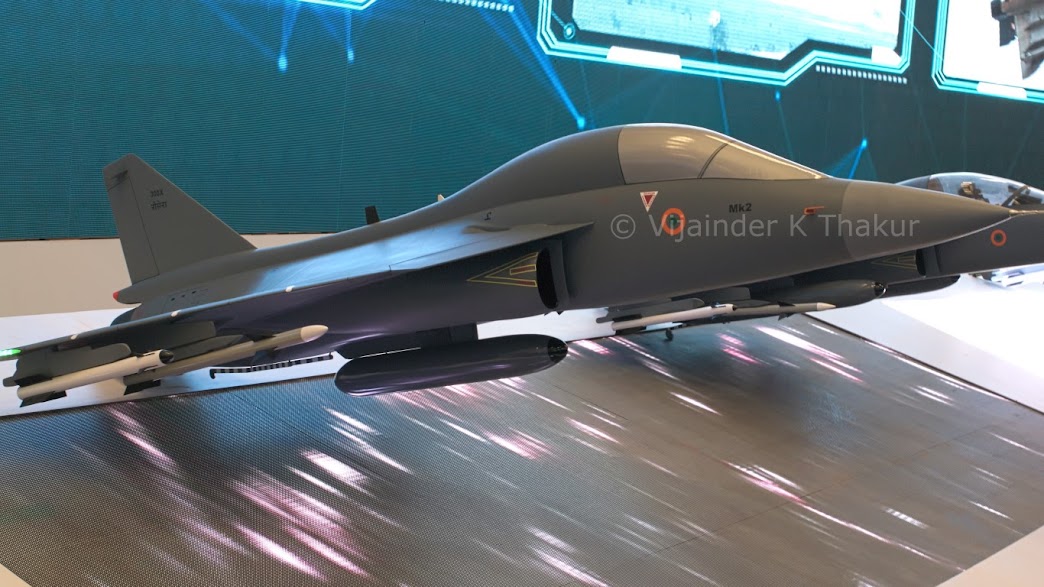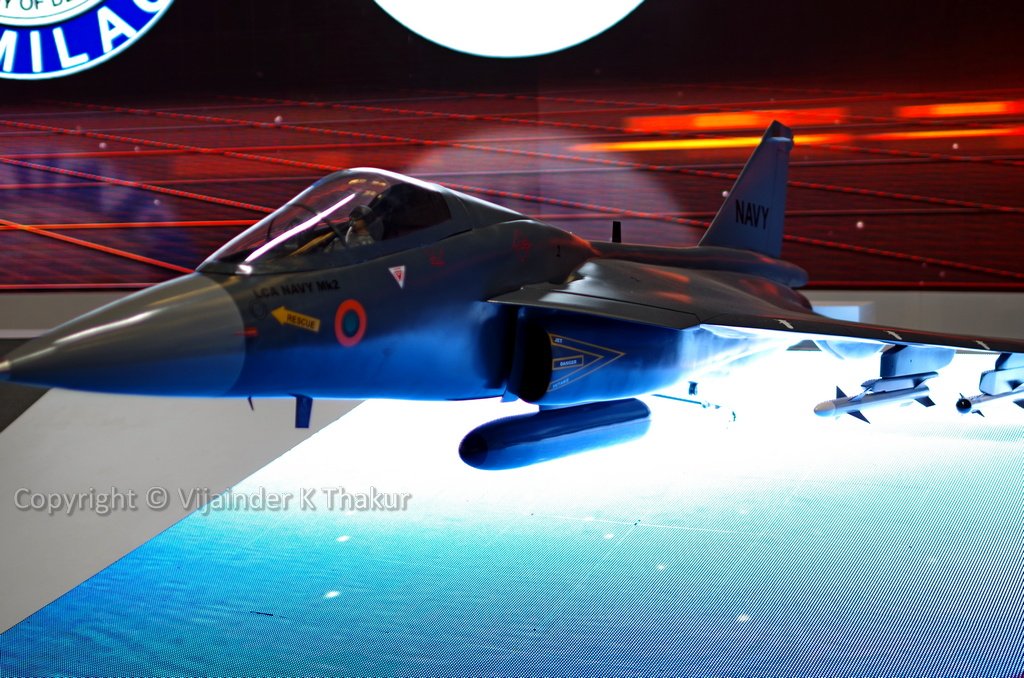LCA Navy Mk.1 at Aero India 2017
On December 2, 2017, the Chief of Naval Staff Admiral Sunil Lanba told the press that the Indian Navy is scouting for another carrier operations compatible fighter besides the MiG-29, since LCA Navy lacks the payload required to be effective when operating from a carrier.
“The present LCA Navy does not meet the carrier capability which is required by the Navy. We will continue to support the Defense Research and Development Organization (DRDO) and Aeronautical Development Agency (ADA) in their efforts to develop a carrier-based fighter aircraft. At the same time we will seek aircraft elsewhere which can operate on the aircraft carrier,” said Admiral Lanba.
On January 24, 2017 the Indian Navy went ahead and released a RFI for procurement of approximately 57 Multi role carrier borne fighters (MRCBF) for aircraft carriers of the Indian Navy (IN).
However, speaking to the press in February 2017, ADA Director Commodore C D Balaji (Retd.) said that the Navy Chief's December remark that the LCA Navy lacked adequate payload was restricted to LCA Navy Mark I.
"...We knew (it) was a heavier platform upfront and it was basically a technology demonstrator and that is how it is intended," he said.
Recalling the development testing underway since 2016, Balaji said "....we will convert this project into a product and that will happen once we do an arrested recovery (by mid of this year), the moment we do that we will carry the learning into Mark II which has already been designed."
Clearly, the IN and ADA are not on the same page on the future of LCA Navy. The Navy wants to support LCA Navy as a technology development project, but ADA wants to see LCA Navy Mk.2 operationally embarked on IN aircraft carriers.
ADA is reported to have vigorously lobbied with RM Manohar Parrikar to keep the LCA Navy Mk.2 project alive. ADA's desire is well intentioned and widely supported by defense enthusiasts who believe that in order to become a great power India must equip its forces with home made weapon systems.
However ADA's attempt to arm twist the IN through the RM to eventually accept LCA Navy Mk.2 for embarkation makes little sense because despite a more powerful engine (LCA Mk.2's F414 has 10% greater thrust than the Mk.1's F404 engine) and optimized design, LCA Navy Mk.2 will fall woefully short of IN requirements specified in its MRCBF RFI.
Scale model of LCA Navy Mk.2 armed with 4 air-to-air missiles at Aero India 2015
LCA Navy Mk.2 Limitations
ADA's aggressive plugging of LCA Navy Mk.2 suggests that the Mk.2 is as capable as the MRCBF that the navy is seeking. This is far from the truth. The extra thrust of the F414 engine would make the LCA Navy Mk.2 more maneuverable but will not significantly increase its weapon load, which the IN considers inadequate. The extra thrust would come at the cost of higher fuel consumption, particularly close to max power setting, negating some of the benefits accruing from the 700 liter extra fuel that the Mk.2 would carry.LCA Navy Mk.2 will be a more capable air defense (AD) fighter than the Mk.1 but will continue to lack credibility as a strike aircraft. It's range and weapon load carrying capacity would be limited even when operating from 3000m runways, let alone when conducting STOBAR operations from a 200m carrier deck.
It's worth noting that the ADA itself plugs LCA Navy Mk.2 as an AD fighter that would provide cover to a carrier group against fighter and cruise missile threats, not as a strike fighter. Scale models of LCA Navy Mk.2 displayed at Aero India 2015 and Aero India 2017 were shown carrying just four air to air missiles (two on each wing) with a center-line drop tank.
Ironically, the IN RFI defines operationally clean configuration (OCC) for the MRCBF to imply that it's carrying four Beyond Visual Range (BVR) missiles and two All Aspect Air-to-Air Missiles (A4M). A total of six missiles, two more than the LCA Navy Mk.2 would carry!
Scale model of LCA Navy Mk.2 at Aero India 2017
Understanding IN Requirement
Carrier groups are primarily strike groups, capable of delivering sustained fire power while operating at considerable distance from home shores. Typically, an aircraft carrier embarks only one fighter type to minimize logistics and maintenance overheads. The primary role of the embarked fighter is strike, so it must features good weapon load and range. Since strike missions often require escort fighters and escort jammers, embarked fighters must also be capable of undertaking these roles.An embarked multi-role fighter allows mission planners to change the force mix - strike, escorts, jammer - based on how heavily adversary airspace is contested. The single embarked aircraft type is reconfigured for its assigned task.
The US F/A-18E/F, the French Rafale-M, and the Chinese J-11 are examples reconfigurable, multi-role carrier borne fighters with good weapon load and range.
The IN wants a MRCBF - Multi Role Carrier Borne Fighter, and the LCA Navy Mk.2's credentials as a multi-role fighter are weak.
It would not be a good idea to embark LCA Navy Mk.2 aircraft on INS Vikramaditya or INS Vikrant alongside MiG-29Ks, as ADA seems to suggest in its brochures and presentations. Having two fighter types on board, would dramatically push up maintenance and logistics infrastructure requirements. More importantly, it would constraint mission planners, deprive them of the flexibility in selecting force mix. Mission force mix would become dependent on embarked force mix! For example, when operating in uncontested airspace LCA Navy Mk.2s would have little to do.
The USN does not embark two fighter types on its super carriers capable of hosting 60 fighters. IN carriers are much smaller and embark around 20 fighters. Operating constraints will become severe. With 60% serviceability and even split of embarked types - INS Vikramaditya would be able to field just 6 MiG-29Ks and 6 LCA Navy Mk.2s at a time, hardly a credible strike force!
Other RFI Shortfalls
Besides limited range and weapon load, LCA Navy Mk.2 would fall short on many other requirements specified in the Navy RFI.Radar and EW Suite
The RFI specifies a radar capable of engaging airborne and surface target, preferably in a interleaved mode. The aircraft should be equipped with a Radar Warning Receiver (RWR) capable cuing an on-board Airborne Self Protection Jammer (ASPJ), Counter measures dispensing suite (CMDS), Missile Approach Warning System (MAWS) and towed decoy for handling threats?Interchangeability / Modularity
The Navy RFI also stipulates high degree of interchangeability / modularity - all major airframes components / parts / panels, sub-assemblies, including the canopy should be fully interchangeable between aircraft. Hot and cold engine sections should swapable. It should be possible to change the engine of an aircraft on the carrier itself.These requirements are easily understood considering that an aircraft carrier could be operating hundreds of miles from home shores. Interchangeability allows recourse to cannibalization to keep more aircraft airworthy. To achieve interchangeability, ADA as the design agency and HAL as the production agency would need to achieve better design and production standards.
Conclusion
Clearly, when drafting the RFI the IN was visualizing Chinese carriers and nuclear submarines in the Indian Oceans, perhaps adversary beachheads on several Andaman and Nicobar group islands. The Navy was probably thinking Super Hornet and Rafale-M, both twin engined medium fighters. Competing against the Super Hornet, the LCA Navy Mk.2 with just one of the two engines fitted on the US Navy fighter would be clearly out of league.LCA Navy equipped IN carriers aren't going to be enough to deter PLAN forays into the Indian Ocean, so should the IN still procure them to help India achieve self sufficiency in arms production?
Rather than pushing the LCA Navy Mk.2 as the right MRCBF for the IN, ADA would better serve the nation's interest by focusing on AMCA development. ADA certainly doesn't have the infrastructure and talent to pursue both projects simultaneously.
But ADA should continue to pursue LCA Navy as a technology demonstrator, something the Navy wants it to do. After ADA masters arrested landing, as it plans to do later this year, the agency should pursue auto-landing on deck and other relevant technologies, so that when the AMCA project gets a green light, ADA has all that it needs to develop the AMCA Naval variant.

.jpg)
